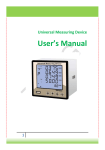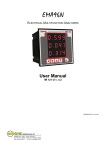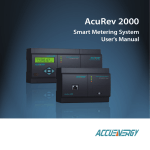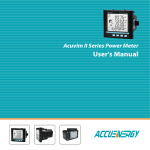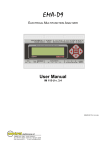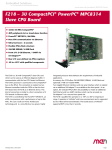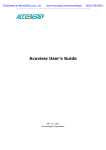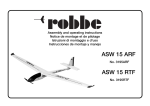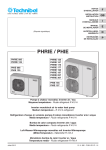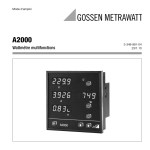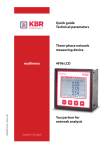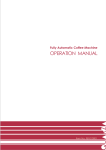Download Manual - AYA Instruments
Transcript
Acuvim 300 Series Multifunction Power Meter User’s Manual CopyRight © 2011 V1.101 This manual may not be altered or reproduced in whole or in part by any means without the expressed written consent of Accuenergy. The information contained in this document is believed to be accurate at the time of publication, however, Accuenergy assumes no responsibility for any errors which may appear here and reserves the right to make changes without notice. Please ask the local representative for latest product specifcations before ordering. [ Document #1080C1101 Revision Date: Nov., 2011] I Please read this manual carefully before installation, operation and maintenance of Acuvim 300 series meter. The following symbols in this manual are used to provide warning of danger or risk during the installation and operation of the meters. Electric Shock Symbol: Carries information about procedures which must be followed to reduce the risk of electric shock and danger to personal health. Safety Alert Symbol: Carries information about circumstances which if not considered may result in injury or death. Prior to maintanence and repair, the equipment must be de-energized and grounded. All maintainence work must be performed by qualified, competent accredited professionals who have received formal training and have experience with high voltage and current devices. Accuenergy shall not be responsible or liable for any damages or injuries caused by improper meter installation and/or operation. II Content Copyright ------------------------------------------------------------------------------------------------------------------ I About Safety ------------------------------------------------------------------------------------------------------------- II Content ----------------------------------------------------------------------------------------------------------------- III Welcome to Acuvim 369------------------------------------------------------------------------------------------------------ IV Chapter 1 Introduction -------------------------------------------------------------------------------------------------------------1 1.1 Meter Overview -------------------------------------------------------------------------------------------------------2 1.2 Areas of Application -------------------------------------------------------------------------------------------------3 1.3 Acuvim 300 Series -------------------------------------------------------------------------------------------------3 Chapter 2 Installation -----------------------------------------------------------------------------------------------------------7 2.1 Appearance and Dimensions -----------------------------------------------------------------------------------8 2.2 Installation Methods ----------------------------------------------------------------------------------------------------10 2.3 Wiring----------------------------------------------------------------------------------------------------------------12 2.4 IO Extension------------------------------------------------------------------------------------------------------------------21 Chapter 3 Meter Display and Operation ------------------------------------------------------------------------------------------29 3.1 Display Panel and Keys---------------------------------------------------------------------------------------------30 3.2 Metering Data----------------------------------------------------------------------------------------------------------32 3.3 Statistic Data--------------------------------------------------------------------------------------------------------36 3.4 System Parameter Settings -------------------------------------------------------------------------------------------42 3.5 IO Parameter Settings -------------------------------------------------------------------------------------------48 3.6 Parameter Introductions ------------------------------------------------------------------------------------55 Chapter 4 Communication -----------------------------------------------------------------------------------63 4.1 Modbus Protocol Introduction --------------------------------------------------------------------------64 4.2 Communication Format ------------------------------------------------------------------------------------------67 4.3 Communication Address Table ----------------------------------------------------------------------------72 Appendix ---------------------------------------------------------------------------------------------------------------------------91 Appendix A Technical Data and Specifications -----------------------------------------------------------------92 Appendix B Ordering Information -------------------------------------------------------------------------------------96 Appendix C Revision History -------------------------------------------------------------------------------------------------98 III Welcome to Acuvim 300 You have purchased an advanced, versatile, multifunction power meter. This meter can work as a remote terminal unit (RTU) that contributes to your system's stability and reliability by providing real-time power quality monitoring and analysis. When you open the package, you will fnd the following items: 1.Acuvim 300 meter x1 2.Terminal Blocks x1~x7 (depending on the model) 3.Installation Clips x2 (already assembled to meter) 4.Product Disk (containing User's Manual and Warranty Card) x1 Chapter 1 Introduces the basic Acuvim 300 features and applications. Chapter 2 Provides details on how to install Acuvim 300 and how to wire terminals and cables. Chapter 3 Walks you through how to program Acuvim 300 via the front panel, display metering data and how to set parameters. Chapter 4 Detailed information related to communcations, including communcation protocol formats and parameter address mapping. Appendix Provides all Acuvim 369 technical data and specifications, ordering information, etc. IV Chapter 1 Introduction 1.1 Meter Overview 1.2 Areas of Application 1.3 Acuvim 300 Series 1 1.1 Meter Overview Powerful yet Cost-effective Acuvim 300 series multifunction power meter utilizes advanced microchip technology and DSP technology. Electrical parameters that can be measured includes Voltage, Cu rrent, Power, Reactive Power, Apparent Power, Power Factor, Frequency, Energy, React ive Energy, Apparent Energy, Demand, Peak Demand, Harmonics (2nd~31st order). In addition, it has Time of Use feature, including Tarriffs, Daylight Savings Time and Decade Holiday Settings. Acuvim 300 series are equipped with True-RMS measuring processor, which ensures it measures electrical parameters accurately in a high-harmonic polluted environment. It fits in medium/low voltage distribution network, electrical instrument, power automation, plant automation etc. Acuvim 300 series has standard communication port that allows remote monitoring and controlling systems. Mutilple IO interfaces meets the users' demand of digital and analog inputs or outputs. Acuvim 300 series offers various models, flexible IO extention, which is versatile for different occasions, saving the customers' costs. Compact and Easy to Install Ac u v i m 3 0 0 s e r i e s d i m e n s i o n s m e e t t h e I E C s t a n d a rd 9 2 m m D I N ( S q u a re ) requirements. With a mounting depth of only 65mm, the meter can even fit in small draw out type cabinets. It utilizes a self-lock installation mechanism, eliminating the necessity of fix bolts, which makes installation or removal quick and convenient. User Friendly Interface Acuvim 300 series utilizes a clear high-definition LCD screen with large characters. The LCD screen comes with a brightness adjustable backlight, which ensures easy observation of metering data in any enviornment. With a large LCD screen display, the four keys on the meter front allow users to observe multiple parameter data at the same time. The meter parameter settings can be set either via front panel keys or the communication port. The 2 parameter settings are saved in non-volatile EEPROM, which remains when power is off. High Safety, High Reliability Acuvim 300 series meter was designed according to industrial standards. It can run reliably under high power disturbance conditions. This meter has been fully tested for EMC and safety compliance in accordance with multiple international standards. The casing is highly fire resistant due to high quality, durable engineering plastics. 1.2 Area of Application Acuvim 300 series products can be utilized as Remote Terminal Units (RTU) in power automation systems to provide data monitoring and acquisition. It can also be utilized as a multifunction power meter in a wide range of applications. The true RMS measurement and digital signal processing technology makes the Acuvim 369 ideal in non-linear load systems and other poor power quality environments. Its major application areas are: Energy Management System Power Distribution Automation Sub Metering Smart Building System Power Monitoring Smart Switchboard, Distribution Cabinet Substation Automation Medium/Low Voltage Distribution System 1.3 Acuvim 300 Series In order to meet various customers' requirments, Acuvim 300 offers different functions. Please see Table 1-1 Acuvim 300 series function comparisons. Operational details of the meter will be described in this chapter. This includes viewing real-time metering data and setting parameters using different key combinations. 3 Function Metering Parameter 361 362 382 387 390 398 Voltage V Current I Power P Reactive Power Q Metering Apparent Power S Power Factor PF Frequency Hz Energy Ep Energy Reactive Energy Eq Apparent Energy Es Current, Power Demand Dmd Demand The Maximum of Current and Dmd Power Demand Energy 4 Tariffs Time of Use 12 Seasons Demand Voltage Total Harmonic Distortion Current Total Harmonic Distortion Power Quality Voltage and Current Individual 2nd to 31st Harmonics Digital Input (additional DI 4DI+1PO 24Vdc Auxilary Power Relay Output or Over/Under Limit 2RO Alarming I/O Option RO/DO Energy Pulse Output or Over/Under Limit 2DO Alarming AO Analog Output 2AO Communication RS485 / Modbus-RTU 4 Metering Voltage Current Power Reactive Power Metering Apparent Power Power Factor Frequency Energy Energy Reactive Energy Apparent Energy Voltage Total Harmonic Distortion Power Quality Current Total Harmonic Distortion Relay Output or Over/Under Limit Alarming RO/DO I/O Energy Pulse Output or Over/ Option Under Limit Alarming AO Analog Output Parameter 301 302 322 327 330 V I P Q S PF Hz Ep Eq Es 2RO 2DO 2AO Table 1-1 Acuvim 300 series function comparisons Note: Acuvim 301, Acuvim 302, Acuvim 322, Acuvim 327, Acuvim 330 are multifunction power meters without communication port; Acuvim 361, Acuvim 362, Acuvim 387, Acuvim 390, Acuvim 398 are multifunction power meters without communication port. 5 6 Chapter 2 Installation 2.1 Appearance and Dimensions 2.2 Installation Methods 2.3 Wiring 2.4 IO Extention 7 The installation method is introduced in this chapter. Please read this chapter carefully before beginning installation. 2.1 Appearance and Dimensions Appearance ⑧ ⑨ ⑩ 11 12 ⑦ ⑤ ⑥ 13 Figure 2-1 Acuvim 300 Appearance 8 Part 1 Casing 2 Front Casing 3 Display 4 Key 5 Voltage Input Terminals 6 Current Input Terminals 7 DI Terminals 8 24Vdc Power Supply Terminals 9 Communication Terminals 10 Power Supply Terminals 11 RO/DO Terminals 12 AO terminals 13 Installation Clips Table 2-1 Part name of Acuvim 300 91.00 96.00 Dimensions (mm) 96.00 Description High intensity fire resistant engineering plastics Visible portion after mounting onto a panel. Large LCD display Four keys are used to select display and set Used for voltage input Used for current input 4-channel Digital Input terminal 24Vdc power supply terminal Communication output Power supply terminal 2-channel RO/DO terminal 2-channel AO terminal Used for securing the meter to the panel 53.50 65.00 14.5 Front View Side View Figure 2-2 Acuvim 300 Dimensions 9 2.2 Installation Methods Environmental Before installation, please check the environment, temperature and humidity to ensure the Acuvim 300 series meter is being placed where it will not be damaged. 1. Temperature Acuvim 300 operation temperture is -250C~700C. Exceeding this temperature range will cause damage to the meter. Please note it can influence the meter life negatively if the meter operates in extremly high or extremly low temperature environments. Acuvim 300 storage temperature range is -400C~850C. 2. Humidity 5% to 95% non-condensing. 3. Location Acuvim 300 series meter should be installed in a dry and dust free environment. Avoid exposing meter to excessive heat, radiation and high electrical noise sources. Installation Steps: Acuvim 300 series power meter is generally installed into the switchboard panel. 1. Cut a square or round hole on the panel of the switch gear. The cutout size is shown in Figure 2-3.Unit: mm. 10 +0.5 -0.0 92 Cutting 92 +0.5 -0.0 Panel Figure 2-3 Panel Cutout 2. Remove the clips from the meter, and insert the meter into the square hole from the front side. Panel Figure 2-4 Put the meter into the opening 11 3. Install clips on the back side of the meter and secure tightly to ensure the meter is affixed to the panel. See Figure 2-5. Figure 2-5 Install the clips 2.3 Wiring Terminal Strips There are 3 groups of current terminal strips: 12 A. Current and Volage Input Terminal Strips 1 2 3 4 5 6 9 10 11 12 I11 I12 I21 I22 I31 I32 VN V3 V2 V1 B. 24Vdc power supply, Communication, Power Supply Terminal Strips C. DI, RO/DO, AO Terminal Strips 22 23 24 25 26 DI1 DI2 C12 DI3 DI4 27 28 29 30 31 C34 O11 O12 O21 O22 32 33 34 35 AO1+ AO1- AO2+ AO2- Figure 2-6 Acuvim 300 Terminal Strip DANGER Only qualified professionals should install, make sure the power supply is cut off and all wires are deenergized. Failure to do so may result in severe injury or death. Safety Earth Connection Before setting up the meter's wiring, please make sure that the switch gear has an earth ground terminal. Connect both the meter's and the switch gear's ground terminal together. The following ground terminal symbol is used in this user's manual. 13 Power Supply Acuvim 300 series power supply is 100~415 Vac (50/60 Hz) or 100~300 Vdc, which is universally supported. The meter's typical power consumption is very low and can be supplied by an independent source or by the measured load line. A regulator or an uninterrupted power supply (UPS) should be used under high power fluctuation conditions. 100- 415Vac / 100- 300Vdc Power Supply 1A FUSE 19 L 20 N 21 G Acuvim 300 Ground Figure 2-8 Power Supply Choice of wire of power supply could be AWG22-16 or 0.6-1.5mm2. The independent power supply circuit loop must have a fuse or air circuit breaker. The fuse could be 1A/250Vac, time delay type. If circuit breaker is used, a CE certified product with compliance of IEC947 is recommended. Terminal G (21) must be connected to the ground terminal of switchgear. Anisolated transformer or EMC flter should be used in the auxiliary power supply loop if there is a power quality problem in the power supply. 14 1A FUSE Power Supply L L 11 L N N 12 N G G 13 EMC filter Acuvim 300 Figure 2-9 Power supply with EMC filter Voltage Input Voltage input range is 40~400Vac L-N, 70~690 Vac L-L. The range fits three phase low voltage system (not larger than 120V) or high voltage system that has secondary PT 100V. It also fits three phase low voltage system (not larger than 400V) or high voltage system thathas secondary PT 400V. A fuse (typical 1A/250Vac) or air circuit breaker must be used in the voltage input loop. Warning: In no circumstance should the secondary of the PT be shorted. The secondary of the PT should be grounded at one end. Please refer to the wiring diagram section for further details. Please make sure to select an approprate PT to maintain the measurement accuracy of the meter. When connecting using the star confguration wiring method, the PT's primary side rated voltage should be equal to or close to the phase voltage of the system to utilize the full range of the PT. When connecting using the delta confguration wiring method, the PT's primary side rated voltage should be equal to or closeto the line voltage of the system. The wire for voltage input could be AWG16~22 or 0.6~1.5mm2 15 Current Input Current Transformers (CTs) are required in most engineering applications. Typical current rating for the secondary side of the CT shall be 5A (standard) or 1A (Optional), please refer to the ordering information appendix for further details. CTs must be used if the system rated current is over 5A. The accuracy of the CT should be better than 0.5% with rating over 3VA is recommended in order to preserve the meter's accuracy. The wire between CTs and the meter shall be as short as possible. The length of the wire may efect the accuracy. The wire size of current input could be AWG15-16 or 1.5-2.5mm2. Warning: The secondary side of the CT should never be open circuit in any circumstance when the power is on, otherwise it may cause damage to the unit and physical injury. There should never be any fuse or switch in the CT loop. One end of the CT loop should be connected to the ground. Vn Connection Vn is the reference point of the Acuvim 300 series meter voltage input. Low wire resistance helps improve the measurement accuracy. Different system wiring modes require different Vn connection methods. Please refer to the wiring diagram section for more details. Acuvim 300 Wiring The following introduces the wiring scenarios. Please make sure voltage input as well as PT secondary voltage, current input as well as CT secondary current are suitable for the meter. Please note the correct wiring scenario will only work properly with correct parameter setting in the meter (Chapter 3 introduces meter parameter settings). 16 1. Wye mode 3CT (meter setting 3Ln) LINE A B C N 1A FUSE Terminal block 1 I11 2 I12 3 I21 7 4 I22 9 10 11 12 VN V3 V2 V1 Acuvim 300 5 I31 6 I32 Figure 2-10 3LN 3CT connection 2. Wye mode 2CT (meter setting 3Ln) LINE A B C N 1A FUSE Terminal block 1 I11 LOAD 2 I12 3 7 I21 4 I22 9 VN 10 11 12 V3 V2 V1 Acuvim 300 5 I31 6 I32 Figure 2-11 3LN, 2CT connection 17 3. Delta mode 2CT (meter setting 2LL) LINE A B C 1A FUSE Terminal block 1 I11 LOAD 2 I12 9 VN 10 11 12 V3 V2 V1 3 I21 7 Acuvim 300 4 I22 5 I31 6 I32 Figure 2-12 2LL, 2CT connection 4. Direct connection, 3CT (meter setting 3LL) LINE A B C N 1A FUSE Terminal block 1 I11 LOAD 2 I12 3 I21 7 4 I22 9 10 VN 11 12 V3 V2 V1 Acuvim 300 5 I31 6 I32 Figure 2-13 3LL, 3CT connection 18 5. Direct connection, 2CT (meter setting 3LL) LINE A B C N 1A FUSE Terminal block 1 I11 2 I12 3 7 I21 4 I22 9 10 V N V3 11 12 V2 V1 Acuvim 300 5 I31 6 I32 Figure 2-14 3 phase direct connection 2CT 6. Single phase 2 wire (meter setting 1Ln) LINE A N 1A FUSE Terminal block 1 I11 LOAD 9 10 VN 2 I12 V3 37 I21 4 I22 11 V2 12 V1 Acuvim 300 5 I31 6 I32 Figure 2-15 Three phase 2CT connection 19 7. Single phase three wires (wirng mode 3Ln) LINE A B N 1A FUSE Terminal block LOAD 1 I11 2 I12 37 I21 4 I22 9 10 VN V3 11 V2 12 V1 Acuvim 300 5 I31 6 I32 Figure 2-16 Single phase three wire connection 20 2.4 IO Extension Acuvim 300 series supports 4 Digital Inputs, 1 24Vdc auxiliary power supply, 2 Relay Outputs or 2 Digital Outputs, 2 Analog Outputs. Digital Input Acuvim 300 provides 4 dry contact digital input circuits, the terminal numbers are C12, DI1, DI2, C34, DI3, DI4 (28, 29, 30, 31, 32, 33). DI1, DI2 share C12; D13, DI4 share C34. The simplified circuit is shown below: Switch DI+ Optical Coupler 16~30 Vdc DI- OUT Acuvim 300 Figure 2-17 Digital Input 21 When the Switch is open, there is no current flow in the diode side of the optical coupler, the triode is off, OUT is in low state. When the Switch is closed, there is current flow in the diode side, the triode is on, OUT is in high state. In this way, the "high" and "low" state of OUT correspondes to "closed" and "open" state of the switch. The recommendation of the power supply in series connection with Switch is 16-30 Vdc. If the circuit wire is long, the voltage level can be raised. However, the max current should not exceed 7.5 mA. Acuvim 300 provides a 24Vdc DI power supply for user's convenience. The power supply is 1W, terminal blocks are 24+, 24G (13, 15). It can only be used as DI power supply, cannot be used for other purposes. The DI power supply that Acuvim 300 provides has the following wiring scenario. Wire size is AWG 22-16 or 0.5-1.3 mm2 Figure 2-18 Self-Powered Digital Input 22 Relay Output Acuvim 300 series IO option has two relay outputs, which can be used either as remote control operation or over/under limit alarming. The terminals are O11, O12 (28, 29) and O21, O22 (30, 31). Aux Power Supply Medium Relay O11 28 Acuvim 300 29 O12 Medium Relay Coil Figure 2-19 Relay Output The relay outputs are Form A (normally open) electromagnetic relay. If normally closed relay is required, it needs to be specified when the order is placed. The nodal capacity is 3A/250Vac or 3A/30Vdc. If the coil has a high capacity, a medium replay is recommended. The relay outputs have two options. One is latching: the output is "ON" and "OFF" state; the other is Momentary, the output changes from "OFF" to "ON", holding it for a time period "Ton" and then go back to "OFF" state. Ton time can be set as 800ms. The relay control circuit wiring can be chosen as AWG22-16 or 0.5-1.5mm2. DO output Acuvim 300 series IO extension has two Digital Output (DO), which can be used as remote control output, over/under limit alarming, energy pulse output etc. When DO is chosen as remote control or alarm output, the output type is the same as the relay output. The two DO can also be used as energy pulse output, which can be set as energy output or reactive energy output. The pulse constant is 800-6000, pulse width is 60ms. DO utilizes Photo-Mos format. 23 J DO+ Out Photo-MOS Acuvim 300 Power DO- Figure 2-20 Digital Output Analog Output Acuvim 300 series offers two Analog Ouput that can be utilized in DCS system or industrial montioring and controlling equipment. By pressing the buttons or changing the communication settings, it can convert any of the 17 measured data. Please refer to Chapter 3 for detailed configurations. The Analog Output type is voltage type: 0-5V/1-5V (configurable); current type: 0-20mA/420mA (configurable). 24 VCC VCC VO Load VO R1 Load Acuvim 300 R2 Voltage Type Acuvim 300 R Current Type Users should utilize AO within the maximum load capacity. Current Type: max load resistance 500 Ohm Voltage Type: max load current 20 mA Over/Under Limit Alarming Acuvim 300 has over/under limit alarming capability. When the monitored parameter goes beyond/below the preset limit and stays at the level over the preset amount of time delay, the over/under limit alarm will be triggered. RO1/DO1 or RO2/DO2 output can be utilized as alarming output signal. 25 The following example illustrates the alarming function. When Phase B current goes above 180A (CT ratio is set as 200: 5) for over 15 seconds, over limit alarm will be triggered, alarm signal will be set out via RO1/DO1.Setting procedures should be as follows: 1) Configure RO1/DO1 output as Alarming Output, set its mode to 2; 2) Set alarming delay time as 15s; 3) Set alarming parameter as Phase B current, according to alarming parameter table, parameter should be set as 11. 4) Set alarming condition "larger than". The inequality sign should be set as 1; 5) Alarming threshold setting should be set according to: Real value = Set value x (CT1/CT2) / 1000 180A is the alarming value, so Set value = 4500.Therefore, the setting of RO/DO has been completed. If phase B current is larger than 180A and lasts longer than 15 seconds, an alarm will be triggered. Communication Acuvim 300 series meter uses RS485 serial communication and the Modbus-RTU protocol. The terminals of communication are A, B, and S (16, 17 and 18). A is diferential signal +, B is diferential signal - and S is connected to the shield of twisted pair cable. The overall length of the RS485 cable connecting all devices can not exceed 1200m (4000ft). Utilizing a large number of RS485 devices and utilizing a high baud rate will make the communication range shorter. Acuvim 300 works as Slave device, Maser device can be PC, PLC, Data Acuqusition Device, or RTU. In order to improve communcation quality, please pay attention to the following: 26 A high-quality Shielded Twisted Pair cable is very important, AWG22 (0.6mm2) or lower is recommended. Two cables should be different colors. Pay attention to "single point earthing". It means there is only one point of the shielding connected to ground in a single communication link. Every A(+) should be connected to A(+), B(-) to B(-), or it will infuence the network and possibly damage the communication interface. “T” type connection topology should be avoided. This means no new branches except from the starting point. Keep communication cables away as much as possible from sources of electrical noise. When several devices are connected (daisy chain) to the same long communication line, an anti signal reflecting resistor (typical value 120-300Ohm 0.25W) is often used at the end of the circuit (the last meter of the chain) if the communication quality is distorted. 27 28 Chapter 3 Meter Display and Operation 3.1 Display Panel and Keys 3.2 Metering Data 3.3 Statistic Data 3.4 System Parameter Settings 3.5 IO Parameter Settings 3.6 Parameter Introductions 29 Operational details of the meter will be described in this chapter. This includes viewing real-time metering data and setting parameters using different key combinations. 3.1 Display Panel and Keys The front of the Acuvim 300 series meter consists of an LCD screen and four control keys. All display segments are shown in Fig. 3-1 below: 1 2 3 4 Figure 3-1 All display segments shown 30 5 6 Number Display 1 2 Top left corner 3 SET 4 Load type 5 Communication Icon 6 1 7 Unit Display 8 PF, Demand 9 T1/T2/T3/T4 10 Pulse Indicator Description Mainly displays data of voltage, current, power, power factor, frequency etc. Item icon U: voltage; I: current, P: active power; q: reactive power; PF: power factor; S: apparent power; E: energy. Indicates settings page display Small inductor: inductive load; Small capacitor: capacitive load. No icon: no communication; One icon: query sent Two icons: query sent and response received Digital Input (DI) status display voltage: V, kV; current: A, kA: active power: kW, MW; reactive power: kvar, Mvar; apparent power: kVA, MVA; frequency: Hz; active energy: kWh; reactive energy: kvarh; apparent energy: kV Ah; Percetage: %; phase angle: ° Indicates power factor and demand respectively Indicates Critical-peak, On-peak, Mid-peak, Off-peak tariffs Indicator light on: pulse output; Indicator light off: no pulse output. There are four keys on the front panel, labeled F, "", ""and "V/A" from left to right. Use these four keys to read real-time metering data, set parameters and navigate the meter. The following illustrations outlined display and key functions of the Acuvim 390 model. 31 3.2 Metering Data Acuvim 300 normally works in data display mode, which shows real-time measured data, such as voltage, current, power etc. In this mode, the "F". " ", " " and "V/A" keys can be used for a variety of functions as follows: Press "V/A": Displays voltage and current related parameters in data display zone. Every time the "V/A" is pressed, the screen will scroll to the next screen. When the screen reaches the last one, it will go back to the first screen. 1st screen: Display phase voltage U1, U2, U3 U 1 = 2 2 0 . 1 V, U 2 = 2 2 0 . 2 V, U 3 = 2 2 0 . 0 V; I n d u c t i v e load; Communication status is ok. Note: communication status, load type is system information, which is displayed on every screen. Press "V/A" again to scroll to the 2nd screen. 1 2 3 4 5 6 Figure 3-2 Three phase voltage 2nd screen: Display line-line voltage U12, U23, U31. U12=380.1V, U23=380.0V, U31=380.2V; Inductive load; Communication status is ok. Press "V/A" again to scroll to the 3rd screen. 1 2 3 4 5 Figure 3-2 Line-to-line voltage 32 6 3rd screen: Displays all phase current I1, I2, I3.I1=5.002A , I2=5.001A, I3=4.998A; Inductive load; Communication status is ok. Press "V/A" again to return to the 1st phase voltage screen . For Acuvim 398, press "V/A" to display the 4th screen. 1 2 3 4 5 6 Figure 3-4 Phase current 4 th screen: Displays all phase current demand I1_ Demand, I2_Demand, I3_Demand. I1_Demand=4.999A, I2_Demand=5.000A, I3_ Demand=5.000A. Press "V/A" again to return to the 1 st phase voltage screen. Note: when voltage wiring is set as 2LL or 3LL, there is no phase voltage display. When voltage wiring is set as 1Ln, data only has the first line. Figure 3-5 Phase current demand Press " ": In measured data display zone it displays power related paramters. Every time the key is pressed, the screen will be scrolled to the next one. Press "F" to switch between circuits. 1 st screen: display all phase real power P1, P2, P3. P=1.650kW, Q=2.853kvar, S=3.302kVA. Inductive load; Communication status is ok. Press " "to display the 2nd screen. 1 2 3 4 5 6 Figure 3-6 Three phase power 33 2nd screen: display system frequency and power factor. F=50.00Hz, PF=0.500. Press " "to display the 2nd screen. For Acuvim 398, press “”to display the 3rd screen. 1 2 3 4 5 6 Figure 3-7 Three phase reactive power 3 r d s c r e e n : d i s p l a y s y s t e m p o w e r d e m a n d P _ Demand, Q_Demand, S_Demand P_Demand=5.705kW, Q_Demand=0.217kvar, S_ Demand=5.706kVA. Press“” to return to the 1st screen. Figure 3-8 System power demand display Note: when power display value is 9999MW, it means the measured data has already exceeded the meter display range. Press " ": In measured data display zone it displays energy related paramters. Every time the key is pressed, the screen will be scrolled to the next one. Press "F" to switch between circuits. 1st screen: display real energy Ep Ep=18.2kWh, Inductive load; Press " " again to display 2nd screen. 1 2 3 4 Figure 3-9 Real energy 34 5 6 2nd screen: display reactive energy Ep Eq=13.2 kvarh Press " " again to display 3rd screen. 1 2 3 4 5 6 Figure 3-10 Reactive energy 3rd screen: display apparent energy Es Es=23.2 kVAh. Press " " again to return to the first screen. For Acuvim 398, press " " again to display the 4 th screen. 1 2 3 4 5 6 Figure 3-11 Apparent energy 4th screen: display meter current time. The time in the left figure shows 11: 02, May 6, 2011 Inductive load Press " " again to return to the first screen. Figure 3-12 Meter clock display 35 Press "F": display harmonics information. Every time "F" is pressed, the screen will scroll to the next screen. 1st screen: Voltage Total Harmonic Distortion U1_Thd=2.03%, U2_Thd=1.88%, U3_ Thd=2.28%; Inductive load; press“”to display the 2nd screen. 1 2 3 4 5 6 Figure 3-13 Voltage THD 2nd screen: Current Total Harmonic Distortion I1_Thd=2.13%, I2_Thd= 2.28%, I3_Thd = 1.36%. Press " " to return to the 1st screen. 1 2 3 4 5 6 Figure 3-14 Current THD 3.3 Statistic Data Acuvim 398 can display max demand and Time of Use Energy. Pressing "F" and“”simultaneously will display max demand. Pressing “”and "F" simultaneously will display "Critical-peak", "On-peak", "Mid-peak", "Off-peak" Time of Use Energy. Press "F" + "": display current max demand. 36 1st screen: current max demand I1_Demand_max=5.000A, I2_Demand_max=4.999A, I3_ Demand_max=4.999A. Inductive load; communication status okay. Press "V/A" to display the 2nd screen. Figure 3-15 Current demand max display 2nd screen: Power demand max display P _ D e m a n d _ m a x = 5 . 7 0 5 k W, Q _ D e m a n d _ max=0.217kvar, S_Demand_max=5.706kVA; Inductive load Press "V/A" to return to the 1st screen. Press "F" and “”to exit to voltage display. Figure 3-16 Power demand max display Time of Use Energy display Press “”+ "V/A": display Time of Use Energy 1st: screen "Total" energy. Ep=698.3kWh; Inductive load Press "V/A" to display the second screen. Figure 3-17 "Total" energy display 37 2nd screen: "Total" reactive energy Eq=52.4kvarh; Inductive load Press "V/A" to display the 3rd screen. Figure 3-18 "Total" reactive energy display 3rd screen: "Total" apparent energy Es=727.1kVAh; Inductive load Press "V/A" to return to the 1st screen. If "F" is pressed, it will display "Critical-peak" energy in the 4th screen. Figure 3-19 "Total" apparent energy display 4th screen: "Critical-peak" energy Ep=93.2kWh, T1 stands for "Critical-peak" Inductive load Press "V/A" to display the 5th screen. Figure 3-20 "Critical-peak" energy display 38 5th screen: "Critical-peak" reactive energy Eq=0.0kvarh; Inductive load Press "V/A" to display the 6th screen. Figure 3-21 "Critical-peak" reactive energy display 6th screen: "Critical-peak" apparent energy Es=94.6kVAh; Inductive load Press "V/A" to return to the 4th screen. If "F" is pressed, it will display "Peak" energy in the 7th screen. Figure 3-22 "Critical-peak" apparent energy display 7th screen: "On-peak" energy Ep=116.9kWh; "T2" stands for "On-peak". Inductive load Press "V/A" to display the 8th screen. Figure 3-23 "On-peak" energy display 39 8th screen: "On-peak" reactive energy Eq=0.0kvarh; Inductive load Press "V/A" to display the 9th screen. Figure 3-24 "On-peak" reactive energy display 9th screen: "On-peak" apparent energy Es=117.0kVAh; Inductive load Press "V/A" again to return to the 7th screen. Pressing "F" key will display "Valley" energy. Press "V/A" to switch different energy type under the same tariff. Press "F" to switch among different tariffs. Press “” to display demand data of Time of Use. Figure 3-25 "On-peak" apparent energy display 1st screen: "Total" power demand P_D emand=5.705kW, Q_D emand=0.217k var, S_ Demand=5.706kVA; Inductive load Press "V/A" to display the 2nd screen. Figure 3-26 "Total" power demand display 40 2nd screen: "Total" current demand I1_Demand=5.000A, I2_Demand=4.999, I3_ Demand=4.999A; Inductive load Press "V/A" to return the first screen. If "F" is pressed, the 3rd screen "Critical-peak" power demand will be displayed. Figure 3-27 "Total" current demand display 3rd screen: "Critical-peak" power demand P_Demand=5.705kW, Q_Demand=0.217k var, S_ Demand=5.706kVA; "T1" stands for "Critical-peak". Inductive load Press "V/A" to display the 4th screen. Figure 3-28 "Critical-peak" power demand display Figure 3-29 "Critical-peak" current demand display 4th screen: "Critical-peak" current demand I1_Demand=5.000A, I2_Demand=4.999A, I3_ Demand=4.999A; Inductive load; Press "V/A" to return to the 3rd screen. Pre s s i n g " F " k e y w i l l d i s p l ay " O n - p e a k " p owe r demand. Press "V/A" to switch different energy type under the same tariif. Press "F" to switch among different tariffs. Press “”to return to "Total" power demand. Press “”and "V/A" to exit to voltage display. 41 3.4 System Parameter Setting Pressing "F" and "V/A" simultaneously will activate the parameter setting mode. At the same time, "SET" is displayed on the top left corner. In parameter settings mode, "F" key is to move the cursor. Every time the key is pressed, the cursor will move one digit to the right, the number where the cursor stays will be flashing. " " is to increase the value, " " is to decrease the value. "V/A" key is for confirmation on the change, and scroll to the next settings screen. On any parameter setting screen, pressing "F" and "V/A" keys together will exit parameter settings mode and return to the measured data display mode. Parameter settings mode is password protected. A four digit password (0000 to 9999) is required everytime before accessing the parameter settings mode. The default password is 0000.After entering the password, press "V/A" to go to the parameter selection page. The meter will return to the metering mode if a wrong password is entered. The following is the parameter settings mode: Password Protection: Users need to enter the password. Figure 3-30 Password 42 1 st screen: Communication address setup. It is used to set communication address, which can be any integer 1-247.The left figure shows the address is 1.To change: press "F" to move the cursor to the digit to be changed, press “” to increase value or“” to decrease value. Then press "V/A" to confirm and scroll to the next screen. If no change needs to be done, press "V/A" to scroll to the next screen. Figure 3-31 Communication address setting Figure 3-32 Communication baud rate setting Note: Modbus-RTU communication protocol requires that all meters on the same bus should have different addresses. 2nd screen: Baud rate setting page. Baud rate can be set 1200, 2400, 4800, 9600, 19200, 38400. The figure on the left indicates the baud rate is 9600 bps. In order to change it, simply press " " or " " to choose a value from the 7 numbers. Press "V/A" to confirm and go to the next screen. Press "V/A" key to confirm and go to the next setting screen. 3 r d s c r e e n : Pa r i t y s e t t i n g p a g e . A c u v i m 3 0 0 series provides parity bit setting. It can be set as Even, Odd, None 1, None 2.None 1 means 8 data bit, no parity bit, 1 start bit, 1 stop bit, no parity bit. None 2 means 8 data bit, no parity bit, 1 start bit, 2 stop bits. Parity setting. uses " " or " " to switch. Press "V/A" to go to the next screen. Figure 3-33 Parity bit setting Note: All devices on the same communication bus should use the same baud rate and parity setting. 43 4 th screen: Meter wiring mode setting. Wiring mode can be set as "3Ln", "3LL", "2LL". Please see Chapter 2 for details. The figure on the left indicates 3Ln. In order to change it, simply press " " or "" to change the value. Press "V/A" to confirm and go to the next screen. Figure 3-34 Wiring mode 5th screen: PT1 setting -- Primary side of PT. PT1 range is 50.0-1000.000.0.unit is Volt. The left figure shows PT1= 400.0V. Users can use P, " " and " " to change PT1 value. Press "V/A" to confirm and go to the next screen. Figure 3-35 PT1 Setting 6th screen: PT2 setting -- Secondary side of PT. The left figure shows PT2 = 400.0V. Users can use P, " " and "" to change PT2 value. Press "V/A" to confirm and go to the next screen. Note: If there is no PT installed, "PT1" and "PT2" should be equal to Acuvim 300 nominal input voltage (400V). Figure 3-36 PT2 Setting 44 7th screen: CT1 setting -- Primary side of CT. Acuvim 300 CT1 range is 5-50000 or 1-50000 (for 1A meter) integer, unit is Amp. CT1=5A, Users can use P, " " and " " to change CT1 value. Press "V/A" to confirm and go to the next screen. Figure 3-37 CT1 Setting 8th screen: CT2 setting -- Secondary side of CT. Acuvim 300 CT2 is fixed as 5 or 1 (for 1A meter), unit is Amp. CT2=5A Press "V/A" to confirm and go to the next screen. Figure 3-38 CT2 Setting 9th screen: Defnition of reactive power. Acuvim 300 has t wo ways to calculate reac tive power: sinusoidal reactive power and Budeanu’s reactive power. Detailed information can be referred to the next chapter. The left figure shows it is using sinusoidal reactive power Figure 3-39 Reactive power definition 45 10th screen: Var/PF Convention Acuvim 300 supports two power factor standards: IEC and IEEE. Press “”and“” to select the standard. The left figure shows IEC is selected. Press "V/A" to confirm and go to the next screen. Figure 3-40 Var/PF convention 11th screen: clear Energy Acuvim 300 energy can be cleared by the front keys. Press “”and“” to switch between "Yes" and "No". If "Yes" is selected, press "V/A" to confirm to clear the energy; If "No" is selected, press "V/A" and it will not clear the energy. Figure 3-41 Clear energy 12th screen: backlight brightness setting Acuvim 300 has 5 levels of backlight brightness. 1 is minimum light level, 5 is maximum light level. The left figure shows leve 5, the brightest. Press "V/A" to confirm and go to the 15th screen. For Acuvim 398, it will go to the 13th screen. Figure 3-42 Backlight brightness 46 13th screen: sliding windows time for demand setting. Sliding windows time of demand can be set from 1-30 minutes. The window slides once per minute. The left figure shows demand window is set as 15 minutes. Press "V/A" to confirm and go to the next screen. Figure 3-43 Sliding window demand 14th screen: demand clear Press “”and“” to switch between "Yes'" and "No". If "Yes" is selected, press "V/A" to confirm to clear the demand; If "No" is selected, press "V/A" and it will not clear the energy; Figure 3-44 Demand clear 15th screen: password settings This is the last screen in system parameter setting mode. The password can be changed in this page. It is important to remember the new password. The left figure shows the password is set as 0001. Press "V/A" to confirm and save, and return to the first communication address setting screen. Figure 3-31 Password 47 3.5 I/O Parameter Settings Under system settings mode, press "F" and“”simutaneously to enter extended I/O setting mode. I/O settings configuraiton follows the same system configuration settings. 1st screen: AO1 parameter setting AO1 parameter can be set as Frequenc y, Phase Voltage, Phase Voltage Average, Line Voltage, Line Voltage Average, Current, Current Average, Neutral Current, System Power, System Reactive Power, System Apparent Power, Power Factor (for a total of 18 electric parameters). Their number is 0-17.Due to the fact that different models measure different parameters, AO1 Figure 3-46 AO parameter setting parameter could be different. As the figure shows, set AO1 parameter as Frequency, press "V/A" to confirm and enter the next page. AO parameter setting number is listed as Table 3-2. Table 3-2 AO Parameter Setting Number 0 Hz 8 Ulavg 16 S 48 1 Ua 9 Ia 17 PF 2 Ub 10 Ib 3 Uc 11 Ic 4 Uavg 12 Iavg 5 Uab 13 In 6 Ubc 14 P 7 Uca 15 Q All measuring parameter and analog output relationship is shown as Figure 3-47 and Figure 3-48. mA Analog Output 20 (10)12 (0) 4 45 65 Frequency (Hz) 0 PT1/CT1 Voltage/Current (V/A) PT1×CT1 PT1×CT1 Real/Reactive Power (W/Var) 0 PT1×CT1 Apparent Power (VA) 0.5(C) 1 0.5(L) Power Factor Figure 3-47 4-20/0-20 mA Analog Output Analog Output V 5 (2.5)3 (0) 1 45 65 Frequency (Hz) 0 PT1/CT1 Voltage/Current (V/A) PT1×CT1 PT1×CT1 Real/Reactive Power (W/Var) 0 PT1×CT1 Apparent Power (VA) 0.5(C) 1 0.5(L) Power Factor Figure 3-48 1-5/0-5V Analog Output 49 2nd screen: AO1 range setting Acuvim 300 extended AO provides range setting. Current AO: 0: 0-20mA; 1: 4-20mA Voltage AO: 0: 0-5V; 1: 1-5V; The left figure shows AO1 range is 0-20 mA or 0-5V. Press "V/A" to go to the next screen. Figure 3-49 AO1 range setting 3rd screen: AO2 parameter setting The left figure shows that AO2 parameter is set as Ib. Press "V/A" to go to the next screen. Figure 3-50 AO2 parameter setting 4th screen: AO2 range setting Current AO: 0: 0-20mA; 1: 4-20mA Voltage AO: 0: 0-5V; 1: 1-5V; The left figure shows AO1 range is 4-20 mA or 1-5V. Figure 3-51 AO2 range setting 50 Figure 3-52 RO1/DO1 workng mode setting Figure 3-53 RO1/DO1 alarming parameter setting 1 Hz 9 Ulavg 17 S 2 Ua 10 Ia 18 PF 3 Ub 11 Ib 5th screen: RO1/DO1 working mode setting Acuvim 300 provides Relay Output / Digital Output. Users may only use one of them. RO/DO work mode settings range is 0-3. 0: Voltage Output; 1: Momentary output, high voltage width 800ms; 2: Alarm Output; 3: Energy Pulse Output. When the user chooses relay as output device, RO/DO working mode cannot be set as 3.The left figure shows RO/DO working mode is set as Alarm Output. 6th screen: RO1/DO1 Alarming Parameter Setting When RO/DO is utilized as Alarm Output, alarming parameters need to be set. For more details about Alarm Output, please refer to Chapter 2.4 Over/Under Limit Alarming. Alarming parameter number range is 0-18, which is listed in Table 3-3.When it is set as 0, no alarm output. The left figure shows parameter is set as Ib. Table 3-3 Alarming parameters 4 Uc 12 Ic 5 Uavg 13 Iavg 6 Uab 14 In 7 Ubc 15 P 8 Uca 16 Q 51 7th screen: RO1/DO1 Alarming setpoint setting The alarming setpoint range is any integer between 0 and 8000. The detailed setup methods can be found in Chapter 2.4 Over/Under Limit Alarming. Press "V/A" to go to the next screen. Figure 3-54 RO1/DO1 alarming setpoint setting Figure 3-55 RO1/DO1 alarming delay time setting Figure 3-56 RO1/DO1 alarming inequality setting 52 8th screen: RO1/DO1 Alarming delay time setting RO1/DO1 delay time setting range is 0-255, unit: second The left picture shows the delay time is 15 seconds. When the alarming condition is met, an alarm will be triggered in 15 seconds. However, if the alarming condition is not longer met, within 15 seconds, it will cancel the alarm. 9th screen: RO1/DO1 Alarming delay time setting When the alarming inequality is set as 1, the condition is "larger than", which means the alarm triggering condition is when the alarming parameter is larger than the setpoint value; When the inequality is set as 0, the condition is "sallmer than", which means the alarm triggering condition is when the alarming parameter is smaller than the setpoint value. The left figure shows RO1/DO1 alarming inequality is set as 1, which means the alarm triggering condition is when the parameter is larger than the setpoint value. 10th screen: RO2/DO2 working mode setting The left figure shows RO2/DO2 working mode is set as 3 -- Energy Pulse Output. Press "V/A" to go to the next screen. Figure 3-57 RO2/DO2 working mode setting 11th screen: RO2/DO2 alarming parameter setting When RO2/DO2 working mode is set as Alarming Output, the set method is the same as RO1/DO1, Figure 3-58 RO2/DO2 alarming mode setting 12th screen: RO2/DO2 alarming setpoint setting When RO2/DO2 working mode is set as Alarming Output, the set method is the same as RO1/DO1. Figure 3-59 RO2/DO2 alarming setpoint setting 53 13th screen: RO2/DO2 alarming delay time setting When RO2/DO2 working mode is set as Alarming Output, the set method is the same as RO1/DO1. Figure 3-60 RO2/DO2 alarming delay time setting 14th screen: RO2/DO2 alarming delay time setting When RO2/DO2 working mode is set as Alarming Output, the set method is the same as RO1/DO1. Figure 3-61 RO2/DO2 alarming inequality setting 15th screen: DO1 pulse energy output selection. Select which energy type the DO1 output is. 0 None 1: Output energy 2: Output reactive energy Figure 3-62 DO1 pulse energy output selection 54 16th screen: DO2 pulse energy output selection. Select which energy type the DO2 output is. 0 None 1: Output energy 2: Output reactive energy Figure 3-63 DO2 pulse energy output selection 17th screen: pulse constant setting Range: 800-6000 Unit: pulse / kWh (kvarh) The left figure shows pulse constant is set as 3600.Press "V/A" to return to the first screen setting. To exit extended IO mode, press "F" and “” simutaneously to exit to the system parameter settings mode. Figure 3-64 DO2 pulse constant setting 3.6 Parameter Introductions Acuvim 300 measures multiple electric paramters, which are introduced in the following: Voltage (U): True RMS value of three phase voltages, three line to line voltages. Current (I): True RMS value of three phase current, average current and neutral line current. Power (P): Total system power Reactive Power (Q): Total reactive power. 55 In sinusoidal or non-sinusoidal systems, reactive power meets: 2 Q1 + D 2 = S 2 − P 2 Q1 is True reactive power; D is Budeanu’s distortion power. 2 Q ' = Q1 + D 2 is Generalized reactive power. In a pure sinusoidal system, since Budeanu's distortion power is 0, Generalized reactive power equals True reactive power. However, in a non-sinusoidal system, Generalized reactive power is larger than True reactive power. Acuvim 300 can measure the reactive power above. Apparent Power (S): Total system apparent power Power Factor (PF): System average power factor Frequency (F): The phase voltage input is measured as the system frequency (priority is V1, V2, V3). Energy: Acuvim 300 can measure energy, reactive energy and apparent energy. Power Factor Standards: Acuvim 300 supports two standards -- IEC and IEEE. The factory default is IEC. The two standards are illustrated in Figure 3-65. 56 Reactive Power Import Reactive Power Import Power Import Power Import IEC Convention IEEE Convention Figure 3-65 Power Factor Convention Harmonic Parameters Total Harmonic Distortion: this factor is often used to express the power quality of the power system. The formula is as follows: THD = 2 Uh × 100% ∑ h = 2 U1 50 In the formula, U1 is Rms value of the voltage fundamental and Uh is Rms value ofthe voltage harmonic with order n. Each Harmonic Rate: the percentage of each harmonic is divided by the fundamental. For Voltage, HRUh = Uh ×100 % U1 HRIh = Ih ×100 % I1 For Current, 57 Demand: Acuvim 398 uses sliding window method for demand calculation. It can measure current demand, power demand, reactive power demand and apparent power demand. Demand interval can be selected from 1 to 30 minutes. Demand window slides one minute each time. For example, the demand interval is set as 3 minutes. If the total power of the 1st minute is 12, the 2nd minute is 14 and the 3rd minute is 10, the total power demand of the 3 minutes is (12+14+10)/3=12.If another minute passed by (the 4th minute) and the total power for the minute is 9, the total power demand after 4 minutes, according to the 3 minute interval, should be (14+10+9)/3 = 11. Max/Min: Acuvim 398 meter can measure the max value of real system power, reactive power and apparent power and the max/min of the three phase voltage and current. The data is stored in non-volatile memory and can be accessed or cleared via meter front or communication. Energy: The energy measurement type includes Real-time energy measurement and Time of Use energy measurement. The function is described as follows: Real time energy: the accumulation of energy for the system kWh, kvarh and kVAh since cleared last. Time of Use energy: User can assign up to 4 diferent tariffs ( Critical-peak, Onpeak, Mid-peak, Off-peak) to different time period within a day according to the billing requirements. The meter will calculate and accumulate energy to different tariffs according to the meter’s internal clock timing and TOU settings. TOU setting: User can set a maximum of 12 TOU seasons, each season can be assigned to a TOU schedule (a maximum of 14 TOU schedules are available). Each schedule can be divided up into 14 segments (in which each segment can have its own tariff ). 58 User can customize the TOU calendar (including its tariffs, seasons, schedules and segments) according to diferent applications. To make sure that the TOU calendar is setup correctly, the meter will check the TOU settings according to the predefined rules (see below for “TOU setting format requirement”for details). TOU function will be disabled if the TOU calendar is set up incorrectly. If no errors are found in the calendar and the TOU function is enabled, TOU energy accumulation will begin. TOU setting format requirments: 1.Season setting parameter: The calendar year will be divided up into different seasons depending on the season setting parameter. The parameter can be selected from any integer between 1 to 12.User must enter the correct value for the season setting parameter in accordance to the TOU season table. If the season setting parameter is set as 2, the first 2 slots of the TOU season table must be set, otherwise it will be considered as an invalid input (TOU function will be disabled). 2.Season format: Enter the start date into the TOU season table slot following this format “MM-DD ID” - MM stands for the month, DD stands for the day and ID stands for the TOU schedule ID (available from 01 to 14). The dates should be organized so that they are in sequence according to the calendar year (the earlier date comes first and the later date comes last). For example, if 3 seasons are selected, the date parameters are January 1, June 6 and September 7, and TOU schedule 02, 01, 03 will be used respectively, the frst TOU season table slot shall enter 01-01 02, the second slot shall enter 06-06 01, and the third slot shall enter 09-07 03.Entering 01-01 02 for the first slot, 09-07 03 for the second slot and 06-06 01 for the third slot is considered invalid. 3.Schedule setting parameter: The number of available TOU schedules depends on the schedule setting parameter. The parameter can be selected from any integer between 1 to 14.This parameter determines the number of TOU schedules available for the TOU calendar setting. A maximum of 14 TOU schedules (from TOU Schedule #1 to TOU Schedule #14) 59 can be used. 4.Segment setting parameter: Each TOU schedule consists of various timing segments. The number of segments depends on the segment setting parameter setup. The parameter can be selected from any integer between 1 to 14 (inclusively). User must enter the correct value for the segment setting parameter in accordance to the TOU schedule table. If the segment setting parameter is set as 3, the frst 3 slots of the TOU schedule table must be set, otherwise, it will be considered as an invalid input (TOU function will be disabled). 5.Tariff setting parameter: Tariff setting is any integer between 0 and 3.It represents the maximum number of tariffs used in TOU energy measurement. For instance, if the tariff setting parameter is set to 3, all of the 4 tariffs will be available; if the parameter is set to 1, only the frst 2 tariffs (Critical-peak and On-peak) will be available; When tariffs number is set, it still needs to be set in Schedule settings, where the tariff will be set as any one of 0, 1, 2, 3 (0 means Critical-peak, 1 means On-peak, 2 means Mid-peak, 3 means Off-peak). 6.Holiday setting parameter: This parameter can be set from any integer between 1 and 30, meaning a maximum of 30 holidays can be programmed to the TOU calendar. If the holiday setting parameter is set as 3, the frst 3 slots of the holiday schedule must be set, otherwise it will be considered as an invalid input (TOU function will be disabled). Note: User can either customize the TOU calendar factory settings or use thedefault factory settings. User can reset the TOU calendar to its default value either via communication. TOU Holiday Use: Firstly set the holiday number, then set the specific holiday, the format is MM-DD Schedule ID. When the meter clock is within the set schedule ID, energy will be accumulated with the tariff associated with the set schedule. Note: Holiday schedule has the highest priority among all the schedules. Weekend schedule: When Weekend schedule is set as 0, it is disabled. When Weekend schedule is set as 1, it means Sunday effective. When Weekend schedule is set as 2, it 60 means Saturday effective. When weekend schedule is set as 3, it means both Saturday and Sunday effective. When Weekend schedule is enabled, bit0 means Sunday; bit1~bit6 mean Week 1 to Week 6.When the meter clock is within the period of weekly interval, energy will accumulate to the tariff associated with the weekend schedule setting. Note: Weekend schedule's priority is followed by Holiday schedule. When Holiday schedule is not enabled, Weekend schedule has the highest priority, overiding the normal (weekday) schedule. Ten-year Holiday setting: Users can preset holidays of next decade via the meter software. The holiday format is month/day/year; holiday code; holiday schedule. After the format setup, click on "Make Holiday Settings (10 year)", then a holiday table for the next decade will be generated. Holiday Auto Switch: When Ten-year Holiday is enabled, if the current year of the meter falls into the Ten-year Holiday setting, it automatically loads the Ten-year Holiday settings into the current TOU settings. If the current year of the meter does not fall into the Ten-year Holiday setting, it remains the current TOU settings. Acuvim 398 can record maximum power and current demand under different tariffs, as well as the time stamp of the maximum value. It can also clear the maximum demand under different tariffs. Daylight Saving Time(DST): When DST is enabled, there are two ways to adjust the clock to DST. If Fixed Date method is chosen, DST will be implemented by a fixed date and time, whose setting format is month/day/hour/minute/ adjustment(unit: minute). If Non-fixed Date method is chosen, DST will be implemented by which day of which week, whose setting format is month/which day (i. e. Tuesday)/which week (i. e. 1st week)/hour/minute/adjustment(unit: minute). There are two ways of automatic resetting of current month TOU. 61 1.End of Month: This is the default method. All values from Current Month TOU will be copied over to Prior Month TOU at the very beginning of each month (the frst day of each month at time 00: 00: 00). Current Month TOU will be cleared and reset to 0. 2.Assigned Clock: User can select when the values from Current Month TOU would be copied over to Prior Month TOU. User can set the time in the following format “DD HH: MM: SS” - DD stands for day, HH stands for hour, MM stands for minute, SS stands for second. Similar to the previous method, once Current Month TOU is transferred to Prior Month TOU, all values from Current Month TOU will be cleared and reset to 0. 62 Chapter 4 Communication 4.1 Modbus Protocol Introduction 4.2 Communication Format 4.3 Communication Address Table 63 This chapter will mainly discuss how to operate the meter via communication port using software. To master this chapter, you should be familiar with Modbus and read other chapters of this manual to make sure that you have a good understanding of the functions and applications of this product. This chapter includes: Modbus protocol, format of communication and data address table. 4.1 Modbus Protocol Introduction ModbusTM RTU protocol is used for communication. Data format and error check methods are defined in Modbus protocol. The half duplex query and respond mode is adopted in Modbus protocol. Modbus allows master device (PC, PLC etc. ) to communicate with slave devices, not allow data exchange between slave devices. In that case, terminal devices will not engage the communcation link at initialization, only response the master's request. 1.Transmission mode The mode of transmission defnes the data structure within a frame and the rules used to transmit data. Coding System 8 bit 1 bit Start bit Data bits 8 bit Odd, Even, No Parity Parity 1 bit/2 bit Stop bit CRC Error checking 64 2.Modbus protocol 2.1 Framing Address Function Data Check 8-Bits 8-Bits N x 8-Bits 16-Bits Table 4-1 Data framing format 2.2 Address Field The address field of a message frame contains eight bits. Valid slave device addresses are in the range of 0-247 decimal. A master addresses a slave by replacing the slave address in the address feld of the message. When the slave sends its response, it places its own address in this address feld of the response to let the master know which slave is responding. 2.3 Function Field The function code field of a message frame contains eight bits. When a message is sent from a master to a slave device the function code field tells the slave what kind of action to perform. Code 01 02 03 05 16 Meaning Read DO status Read DI status Read data Control DO Action Obtain Digital (Relay) Output current status (ON/OFF) Obtain Digital Input current status (ON/OFF) Obtain current binary value from one or more registers Control Digital (Relay) Output(ON/OFF) Place specifc value into a series of consecutive multiplePreset multiple registers registers Table 4-2 Function Code 65 2.4 Data Field Data field contains the data that terminals need to complete the request and the data that terminals response to the request. Note: The sequence of Address, Function Code, Data, CRC check is always the same. 2.5 Error Check Field The field allows the error check by master and slave devices. Due to electrical noise and other interference, a group of data may be changed transmitted from one location to the other. Error Check ensures master or slave devices do not reponse those distorted data during the transmission, which enhanced the system security and efficiency. Error Check uses 16-bit Cyclic Redundancy Check (CRC 16). 2.6 CRC Check Every message includes an error checking field which is based on the Cyclical Redundancy Check (CRC) method. The CRC field checks the contents of the entire message. It is applied regardless of any parity check method used for the individual characters of the message. The CRC field is two bytes long, containing a 16-bit binary value. The CRC value is calculated by the transmitting device, and is appended to the message. The receiving device recalculates the CRC value during reception of the message, and compares the calculated value to the actual value it received in the CRC feld. An error will be reported if the two values are not equal. CRC calculation is frst started by preloading the whole 16-bit register to 1’s. The process begins by applying successive 8-bit bytes of the message to the current contents of the register. Only the eight bits of data in each character are used for generating the CRC. Start and stop bits, and the parity bit, do not apply to the CRC. 66 When generating the CRC, each 8-bit character is exclusive ORed with the register contents. The result is shifted towards the least signifcant bit (LSB), with a zero flled into the most signifcant bit (MSB) position. The LSB is extracted and examined, if the LSB equals to 1, the register is exclusive ORed with a preset, fixed value; if the LSB equals to 0, no action will be taken. This process is repeated until eight shifts have been performed. After the last (eighth) shift, the next 8-bit byte is exclusive ORed with the register’s current value, and the process repeats for eight more shifts as described above. The fnal contents of the register, after all the bytes of the message have been applied, is the CRC value. When the CRC is appended to the message, the low-order byte is appended frst, followed by the high-order byte. 4.2 Communication Format Addr Fun 06H 03H Data start Data start reg Hi reg lo 00H 00H Data#of regs hi 00H Data #of regs lo 21H CRC16 Hi 84H CRC16 Lo 65H Table 4-3 Protocol Illustation Addr: Slave device address Fun: Function Code Data start reg hi: Start register address, high byte Data start reg lo: Start register address, low byte Data #of reg hi: Number of register, high byte Data #of reg lo: Number of register, low byte CRC16 Hi: CRC high byte CRC16 Lo: CRC low byte 67 1. Read Relay Output status(Function Code 01) Query The master device sends query frame to the salve deivce. Function Code 01 allows users to acquire the relay output status (ON/OFF) of the slave device with the specified address. On top of slave device address and function code, query frame must contain the relay register starting address and the number of registers to be read. Table 4-4 depicts of reading Relay 1 and Relay 2 status of the slave device with the address of 17. Addr Fun 11H 01H Data start Data start reg Hi reg lo 00H 00H Data#of regs hi 00H Data #of regs lo 02H CRC16 Hi BFH CRC16 Lo 5BH Table 4-4 Query frame of reading Relay Output status Response The slave device anwsers the master device's query. The response frame contains slave device address, function code, data quantity and CRC check. Each relay utilizes one bit(1 = ON , 0 = OFF). Table 4-5 depicts the response frame. Addr 11H Fun 01H Byte count 01H Data 02H CRC16 hi D4H CRC16 lo 89H Data Bytes 7 0 6 0 5 0 4 0 3 0 2 0 1 1 0 0 MSB (Relay 1 = OFF , Relay 2=ON ) Table 4-5 Response frame of reading Relay Output status 68 LSB 2. Read the status of DI (Function Code 02) Query On top of slave device address and function code, query frame must contain the digital input register starting address and the number of registers to be read. DI register address starts from 0000H, DI1=0000H, DI2=0001H, DI3=0002H, DI4=0003H). Table 4-6 depicts of reading DI1 to DI4 status of the slave device with the address of 17. Addr Fun 11H 02H DI start addr Hi 00H DI start addr Lo 00H DI num Hi 00H DI num Lo 04H CRC16 Hi 7BH CRC16 Lo 59H Table 4-6 Query frame of reading DI status Response The slave device anwsers the master device's query. The response frame contains slave device address, function code, data quantity and CRC check. Each DI utilizes one bit(1 = ON , 0 = OFF). Table 4-7 depicts the response frame. Table 4-7 depicts DI1=ON, DI2=ON, DI3=OFF, DI4=OFF. Addr 11H Fun 02H 0 0 Byte count 01H 0 0 0 0 Data 03H DI4 0 DI3 0 MSB CRC16 hi E5H DI2 1 CRC16 lo 49H DI1 1 LSB Table 4-7 Response frame of reading DI status 69 3. Read Data (Function Code 03) Query This function allows the master to obtain the measurement results from the meter. The following table shows how to read the 3 measured data (F, V1 and V2) from slave device number 17, the data address of F is 0130H, V1 is 0131H and V2 is 0132H. Addr Fun 11H 03H Data start addr hi 03H Data start Addr Lo 00H Data #of reg hi 00H Data #of regs lo 03H CRC16 lo 1FH Table 4-8 Read F , U1, U2 query frame Response Response frame contains slave device address, function code, data quantity and CRC check. (F=1388H(50.00Hz) , U1=03E7H(99.9V) , U2=03E9H(100.1V)) Addr Fun 11H 03H Byte count 06H Data1 Data1 Data 2 Data2 Data3 hi Lo hi lo hi 13H 88H 03H E7H 03H Data3 CRC16 CRC16 Lo hi lo E9H 7FH 04H Table 4-9 Read F, U1, U2 response frame 4. Control Relay Output (Function Code 05) Query This query frame forces the relay status to ON or OFF. Data FF00H sets the relay as ON, and data 0000H sets the relay as OFF. The relay will not be influenced by any other data input. The following is to query slave device 17 to set relay status as ON. 70 Addr Fun 11H 05H Do addr Hi 00H Do addr Lo 00H Value Hi FFH Value Lo 00H CRC16 Hi 8EH CRC16 Lo AAH Table 4-10 Control relay status query frame Response The correct response to this request is to send back the received data after the relay status is changed. Addr Fun 11H 05H Do addr Hi 00H Do addr Lo 00H Value Hi FFH Value Lo 00H CRC16 Hi 8EH CRC16 Lo AAH Table 4-11 Control relay status response frame 5. Preset/Reset Multi-Register (Function Code 16) Query Function 16 (Hex) allows the user to modify the contents of multiple registers. The example below is a request to the address of 17 to Preset Ep_imp = (17807783.3 kWh). Since meter storage unit is 0.1 kWh, the number to write into is 178077833. and its HEX value is 0A9D4089H. Ep_imp data address is 0200H and 0201H. Addr Fun 11H 10H Value Hi 0AH Value Lo 9DH Data start reg hi 02H Data start reg lo 00H Value Hi 40H Data #of reg hi 00H Value lo 89H Data #of reg lo 02H CRC hi F8H Byte Count 04H CRC Lo 6CH Table 4-12 Preset Muti-register query frame 71 Response The correct response is to send back address, function code, data starting address, data bytes, CRC check after the value is changed. Addr Fun 11H 10H Data start Data start Data #of reg hi reg lo reg hi 02H 00H 00H Data #of Reg lo 02H CRC16 hi 42H CRC16 lo E0H Table 4-13 Preset Multi-reigster response frame 4.3 Communication Address Table Basic Measurements The data address of basic measurements includes Secondary data address(Table 4-14)and Primary data address (Table 4-16). Address 300H 301H 302H 303H 304H 305H 306H 307H 308H 309H 30AH 30BH 30CH 72 Basic Measurement (Secondary) Parameter Range Frequency F 0-65535 Phase A Voltage U1 0-65535 Phase B Voltage U2 0-65535 Phase C Voltage U3 0-65535 Average Phase Voltage Unavg 0-65535 Line Voltage U12 0-65535 Line Voltage U23 0-65535 Line Voltage U31 0-65535 Average Line Voltage Ull_avg 0-65535 Phase A Current I1 0-65535 Phase B Current I2 0-65535 Phase C Current I3 0-65535 Average Phase Current Inavg 0-65535 Data Type Access Type Word R Word R Word R Word R Word R Word R Word R Word R Word R Word R Word R Word R Word R 30DH 30EH 30FH 310H 311H 312H 313H 314H 315H Neutral Line Current In System Power P System Reactive Power Q System Apparent Power S System Power Factor PF Load Nature RT AO1 Output AO2 Output Phase A Current Demand 0-65535 -32768 - 32767 -32768 - 32767 0-65535 -1000 - 1000 76/67/82(L/C/R) 0-65535 0-65535 0-65535 Word Integer Integer Word Integer Word Word Word Word R R R R R R R R R 316H 317H 318H 319H 31AH Phase B Current Demand Phase C Current Demand Power Demand Reactive Power Demand Apparent Power Demand 0-65535 0-65535 -32768 - 32767 -32768 - 32767 0-65535 Word Word Integer Integer Word R R R R R Table 4-14 Secondary side real-time measurement data address Parameter Voltage Current Power Reactive Power Apparent Power Power Factor Frequency Load Nature (L/C/R) Analog Output(Current Type) Analog Output(Voltage Type) Relationship U=Rx × (PT1 / PT2) /10 I=Rx ×(CT1/CT2) /1000 P=Rx × (PT1 / PT2) × (CT1/ CT2) Q=Rx × (PT1 / PT2) X (CT1/ CT2) S=Rx × (PT1 / PT2) X (CT1/ CT2) PF=Rx / 1000 F=Rx / 100 L/C/R is expressed by low byte AO = Rx /1000; AO = Rx /1000; Unit V A W var VA No Unit Hz No Unit mA V Table 4-15 Real time data conversion 73 Address 600-601H 602-603H 604-605H 606-607H 608-609H 60A-60BH 60C-60DH 60E-60FH 610-611H 612-613H 614-615H 616-617H 618-619H 61A-61BH 61C-61DH 61E-61FH 620-621H 622-623H 624-625H 626-627H 628-629H 62A-62BH 62C-62DH 62E-62FH 630-631H Basic Measurement(Primary) Parameter Frequency F Phase A Voltage U1 Phase B Voltage U2 Phase C Voltage U3 Average Phase Voltage Unavg Line Voltage U12 Line Voltage U23 Line Voltage U31 Average Line Voltage Ull_avg Phase A Current I1 Phase B Current I2 Phase C Current I3 Average Phase Current Inavg Neutral Line Current In System Power P System Reactive Power Q System Apparent Power S System Power Factor PF Load Nature RT Phase A Current Demand Phase B Current Demand Phase C Current Demand Power Demand Reactive Power Demand Apparent Power Demand Data Type Access Type Float R Float R Float R Float R Float R Float R Float R Float R Float R Float R Float R Float R Float R Float R Float R Float R Float R Float R Float R Float R Float R Float R Float R Float R Float R Table 4-16 Primary side real-time measurement data address 74 Data and Time Table Function code: 03H for reading, 16H for presetting. Address 500H 501H 502H 503H 504H 505H 506H Parameter Year Month Day Hour Minute Second Week Range 2000-2099 1-12 1-31 0-23 0-59 0-59 0-6 Data Type Word Word Word Word Word Word Word Access Type R/W R/W R/W R/W R/W R/W R/W Table 4-17 Data and Time Energy Function Code: 03H for reading, 16H for presetting. Address 0200H(High) 0201H(Low) 0202H(High) 0203H(Low) 0204H(High) 0205H(Low) Parameter Range Data Type Access Type Energy Ep 0-999999999 Dword R/W Reactive Energy Eq 0-999999999 Dword R/W Apparent Energy Es 0-999999999 Dword R/W Table 4-18 Real-time energy data 75 Acuvim 398 energy includes real-time energy and Time of Use energy. Real-Time Energy Address Real-time Time of Use Real-Time energy address is in Table 4-18. Time of Use Energy TOU energy addresses include data address of last month TOU energy, data address of current month TOU energy, data address of TOU parameter settings and data address of TOU default parameters. Except for the data address of TOU default parameter, the data address could be read by function code 03, preset by function code 16.TOU default parameter can be read by function code 03, preset by function code 176. Data address of prior month TOU Data address of current month TOU Data address of TOU energy Data address of TOU parameter setting Basic parameter of TOU Season parameter setting of TOU Schedule setting of TOU Holiday setting of TOU Basic default parameter of TOU Data adress of TOU default parameter Season default parameter setting of TOU Schedule default setting of TOU Holiday default setting of TOU 76 Address 206H(High) 207H(Low) 208H(High) 209H(Low) 20AH(High) 20BH(Low) 20CH(High) 20DH(Low) 20EH(High) 20FH(Low) 210H(High) 211H(Low) 212H(High) 213H(Low) 214H(High) 215H(Low) 216H(High) 217H(Low) 218H(High) 219H(Low) 21AH(High) 21BH(Low) 21CH(High) 21DH(Low) 21EH(High) 21FH(Low) 220H(High) 221H(Low) Prior Month TOU Energy (03H-Read, 10H-Write) Parameter Range Data Type Ep_TOU(Critical0-999999999 DWord peak) Eq_TOU(Critical0-999999999 DWord peak) Es_TOU(Critical0-999999999 DWord peak) Access Type R/W R/W R/W Ep_TOU(On-peak) 0-999999999 DWord R/W Eq_TOU(On-peak) 0-999999999 DWord R/W Es_TOU(On-peak) 0-999999999 DWord R/W Ep_TOU(Mid-peak) 0-999999999 DWord R/W Eq_TOU(Mid-peak) 0-999999999 DWord R/W Es_TOU(Mid-peak) 0-999999999 DWord R/W Ep_TOU(Off-peak) 0-999999999 DWord R/W Eq_TOU(Off-peak) 0-999999999 DWord R/W Es_TOU(Off-peak) 0-999999999 DWord R/W Ep_TOU(Total) 0-999999999 DWord R/W Eq_TOU(total) 0-999999999 DWord R/W 77 222H(High) 223H(Low) Address 224H(High) 225H(Low) 226H(High) 227H(Low) 228H(High) 229H(Low) 22AH(High) 22BH(Low) 22CH(High) 22DH(Low) 22EH(High) 22FH(Low) 230H(High) 231H(Low) 232H(High) 233H(Low) 234H(High) 235H(Low) 236H(High) 237H(Low) 238H(High) 239H(Low) 23AH(High) 23BH(Low) 78 Es_TOU(total) 0-999999999 DWord Prior Month TOU Energy(03H-Read, 10H-Write) Parameter Range Data Type Ep_TOU(Critical0-999999999 DWord peak) Eq_TOU(Critical0-999999999 DWord peak) Es_TOU(Critical0-999999999 DWord peak) R/W Access Type R/W R/W R/W Ep_TOU(On-peak) 0-999999999 DWord R/W Eq_TOU(On-peak) 0-999999999 DWord R/W Es_TOU(On-peak) 0-999999999 DWord R/W Ep_TOU(Mid-peak) 0-999999999 DWord R/W Eq_TOU(Mid-peak) 0-999999999 DWord R/W Es_TOU(Mid-peak) 0-999999999 DWord R/W Ep_TOU(Off-peak) 0-999999999 DWord R/W Eq_TOU(Off-peak) 0-999999999 DWord R/W Es_TOU(Off-peak) 0-999999999 DWord R/W 23CH(High) 23DH(Low) 23EH(High) 23FH(Low) 240H(High) 241H(Low) Ep_TOU(Total) 0-999999999 DWord R/W Eq_TOU(Total) 0-999999999 DWord R/W Es_TOU(Total) 0-999999999 DWord R/W Table 4-19 Time of Use energy address The relationship between the communication data value and the real data value is listed below(Rx is the communication value): Parameter Ep Eq Es Relationship Ep= Rx/10 Eq = Rx/10 Es = Rx/10 Unit kWh kvarh kVAh Table 4-20 Energy data conversion table TOU parameter setting addresses include Basic Parameters of TOU, Season Setting of TOU, Schedule Setting of TOU and Holiday Setting of TOU. TOU Basic Parameter Setting (03H-Read, 10H-Write) Address 800H 801H 802H 803H Parameter Season Number Schedule Number Segment Number Tariff Number Weekend Setting (bit0Sunday; bit1~bit6: Monday~Saturday; 804H bit=1 means using energy, bit=0 means not using energy) 805H Weekend Schedule 806H Holiday Number Range Data Type 1-12 1-14 1-14 0-3 Word Word Word Word Access Type R/W R/W R/W R/W 0-127 Word R/W 0-14 0-30 Word Word R/W R/W 79 807H Time of Use 808H Time of Use factory setting 809H 80AH 80BH 80CH 80DH 80EH 80 Choice of TOU energy auto reset (0: End of Month) TOU auto reset fixed date: day (default is 1) TOU auto reset fixed date: hour (default is 0) TOU auto reset fixed date: minute (default is 0) TOU auto reset fixed date: second (default is 0) Error Code(default) 1: Enabled(Default is 1) 1: Enabled(Default is 1) Word R/W Word R/W 1: Fixed Date Word R/W 1-31 Word R/W 0-23 Word R/W 0-59 Word R/W 0-59 Word R/W 0: the setting of parameter is correct 1: tariff setting error 2: schedule setting error 4: segment setting error 8: season setting error 16: parameter of season setting error 32: holiday setting error 64: parameter of holiday setting error 256: tariff of schedule setting error 512: time of schedule setting error 1024: period of schedule setitng error 048: period of weekend setting error 4096: weekend setting error 820H-822H 823H-825H 826H-828H 829H-82BH 82CH-82EH 82FH-831H 832H-834H 835H-837H 838H-83AH 83BH-83DH 83EH-840H 841H-843H 844H-846H 847H-849H Season Setting Starting Date and Schedule of 1st Season (Month, Day, Schedule Number) Starting Date and Schedule of 2nd Season (Month, Day, Schedule Number) Starting Date and Schedule of 3rd Season (Month, Day, Schedule Number) Starting Date and Schedule of 4th Season (Month, Day, Schedule Number) Starting Date and Schedule of 5th Season (Month, Day, Schedule Number) Starting Date and Schedule of 6th Season (Month, Day, Schedule Number) Starting Date and Schedule of 7th Season (Month, Day, Schedule Number) Starting Date and Schedule of 8th Season (Month, Day, Schedule Number) Starting Date and Schedule of 9th Season (Month, Day, Schedule Number) Starting Date and Schedule of 10th Season (Month, Day, Schedule Number) Starting Date and Schedule of 11st Season (Month, Day, Schedule Number) Starting Date and Schedule of 12nd Season (Month, Day, Schedule Number) Schedule Setting Starting Time and Tariff Number of 1st Scheule of 1st Schedule Table (Hour, Minute, Tariff Number) Starting Time and Tariff Number of 2nd Scheule of 1st Schedule Table (Hour, Minute, Tariff Number) Word R/W Word R/W Word R/W Word R/W Word R/W Word R/W Word R/W Word R/W Word R/W Word R/W Word R/W Word R/W Word R/W Word R/W 81 84AH-84CH 84DH-84FH 850H-852H 853H-855H 856H-858H 859H-85BH 85CH-85EH 85FH-861H 862H-864H 865H-867H 868H-86AH 86BH-86DH 86EH-897H 898H-8C1H 8C2H-8EBH 82 Starting Time and Tariff Number of 3rd Scheule of 1st Word Schedule Table (Hour, Minute, Tariff Number) Starting Time and Tariff Number of 4th Scheule of 1st Word Schedule Table (Hour, Minute, Tariff Number) Starting Time and Tariff Number of 5th Scheule of 1st Word Schedule Table (Hour, Minute, Tariff Number) Starting Time and Tariff Number of 6th Scheule of 1st Word Schedule Table (Hour, Minute, Tariff Number) Starting Time and Tariff Number of 7th Scheule of 1st Word Schedule Table (Hour, Minute, Tariff Number) Starting Time and Tariff Number of 8th Scheule of 1st Word Schedule Table (Hour, Minute, Tariff Number) Starting Time and Tariff Number of 9th Scheule of 1st Word Schedule Table (Hour, Minute, Tariff Number) Starting Time and Tariff Number of 10th Scheule of Word 1st Schedule Table (Hour, Minute, Tariff Number) Starting Time and Tariff Number of 11st Scheule of 1st Word Schedule Table (Hour, Minute, Tariff Number) Starting Time and Tariff Number of 12nd Scheule of Word 1st Schedule Table (Hour, Minute, Tariff Number) Starting Time and Tariff Number of 13rd Scheule of Word 1st Schedule Table (Hour, Minute, Tariff Number) Starting Time and Tariff Number of 14th Scheule of Word 1st Schedule Table (Hour, Minute, Tariff Number) Starting Time and Tariff Number of 1st~14th Scheule Same as 1st of 2nd Schedule Table (Hour, Minute, Tariff Number) Schedule Table Starting Time and Tariff Number of 1st~14th Scheule Same as 1st of 3rd Schedule Table (Hour, Minute, Tariff Number) Schedule Table Starting Time and Tariff Number of 1st~14th Scheule Same as 1st of 4th Schedule Table (Hour, Minute, Tariff Number) Schedule Table R/W R/W R/W R/W R/W R/W R/W R/W R/W R/W R/W R/W R/W R/W R/W 8ECH-915H 916H-93FH 940H-969H 96AH-993H 994H-9BDH 9BEH-9E7H 9E8H-A11H A12H-A3BH A3CH-A65H A66H-A8FH A90H-A92H A93H-A95H A96H-A98H A99H-A9BH A9CH-A9EH Starting Time and Tariff Number of 1st~14th Scheule of 5th Schedule Table (Hour, Minute, Tariff Number) Starting Time and Tariff Number of 1st~14th Scheule of 6th Schedule Table (Hour, Minute, Tariff Number) Starting Time and Tariff Number of 1st~14th Scheule of 7th Schedule Table (Hour, Minute, Tariff Number) Starting Time and Tariff Number of 1st~14th Scheule of 8th Schedule Table (Hour, Minute, Tariff Number) Starting Time and Tariff Number of 1st~14th Scheule of 9th Schedule Table (Hour, Minute, Tariff Number) Starting Time and Tariff Number of 1st~14th Scheule of 10th Schedule Table (Hour, Minute, Tariff Number) Starting Time and Tariff Number of 1st~14th Scheule of 11th Schedule Table (Hour, Minute, Tariff Number) Starting Time and Tariff Number of 1st~14th Scheule of 12th Schedule Table (Hour, Minute, Tariff Number) Starting Time and Tariff Number of 1st~14th Scheule of 13th Schedule Table (Hour, Minute, Tariff Number) Starting Time and Tariff Number of 1st~14th Scheule of 14th Schedule Table (Hour, Minute, Tariff Number) Holiday Setting Holiday Date and Schedule Number of 1st Holiday (Month, Day, Schedule Number) Holiday Date and Schedule Number of 2nd Holiday (Month, Day, Schedule Number) Holiday Date and Schedule Number of 3rd Holiday (Month, Day, Schedule Number) Holiday Date and Schedule Number of 4th Holiday (Month, Day, Schedule Number) Holiday Date and Schedule Number of 5th Holiday (Month, Day, Schedule Number) Same as 1st Schedule Table Same as 1st Schedule Table Same as 1st Schedule Table Same as 1st Schedule Table Same as 1st Schedule Table Same as 1st Schedule Table Same as 1st Schedule Table Same as 1st Schedule Table Same as 1st Schedule Table Same as 1st Schedule Table R/W R/W R/W R/W R/W R/W R/W R/W R/W R/W Word R/W Word R/W Word R/W Word R/W Word R/W 83 A9FH-AA1H AA2H-AA4H AA5H-AA7H AA8H-AAAH AABH-AADH AAEH-AB0H AB1H-AB3H AB4H-AB6H AB7H-AB9H ABAH-ABCH ABDH-ABFH AC0H-AC2H AC3H-AC5H AC6H-AC8H AC9H-ACBH 84 Holiday Date and Schedule Number of 6th Holiday (Month, Day, Schedule Number) Holiday Date and Schedule Number of 7th Holiday (Month, Day, Schedule Number) Holiday Date and Schedule Number of 8th Holiday (Month, Day, Schedule Number) Holiday Date and Schedule Number of 9th Holiday (Month, Day, Schedule Number) Holiday Date and Schedule Number of 10th Holiday (Month, Day, Schedule Number) Holiday Date and Schedule Number of 11th Holiday (Month, Day, Schedule Number) Holiday Date and Schedule Number of 12th Holiday (Month, Day, Schedule Number) Holiday Date and Schedule Number of 13th Holiday (Month, Day, Schedule Number) Holiday Date and Schedule Number of 14th Holiday (Month, Day, Schedule Number) Holiday Date and Schedule Number of 15th Holiday (Month, Day, Schedule Number) Holiday Date and Schedule Number of 16th Holiday (Month, Day, Schedule Number) Holiday Date and Schedule Number of 17th Holiday (Month, Day, Schedule Number) Holiday Date and Schedule Number of 18th Holiday (Month, Day, Schedule Number) Holiday Date and Schedule Number of 19th Holiday (Month, Day, Schedule Number) Holiday Date and Schedule Number of 20th Holiday (Month, Day, Schedule Number) Word R/W Word R/W Word R/W Word R/W Word R/W Word R/W Word R/W Word R/W Word R/W Word R/W Word R/W Word R/W Word R/W Word R/W Word R/W ACCH-ACEH ACFH-AD1H AD2H-AD4H AD5H-AD7H AD8H-ADAH ADBH-ADDH ADEH-AE0H AE1H-AE3H AE4H-AE6H AE7H-AE9H AEAH Holiday Date and Schedule Number of 21st Holiday (Month, Day, Schedule Number) Holiday Date and Schedule Number of 22nd Holiday (Month, Day, Schedule Number) Holiday Date and Schedule Number of 23rd Holiday (Month, Day, Schedule Number) Holiday Date and Schedule Number of 24th Holiday (Month, Day, Schedule Number) Holiday Date and Schedule Number of 25th Holiday (Month, Day, Schedule Number) Holiday Date and Schedule Number of 26th Holiday (Month, Day, Schedule Number) Holiday Date and Schedule Number of 27th Holiday (Month, Day, Schedule Number) Holiday Date and Schedule Number of 28th Holiday (Month, Day, Schedule Number) Holiday Date and Schedule Number of 29th Holiday (Month, Day, Schedule Number) Holiday Date and Schedule Number of 30th Holiday (Month, Day, Schedule Number) Ten-year Holiday Setting AEBH Starting year of Ten-year Holiday AECH Ending year of Ten-year Holiday Word R/W Word R/W Word R/W Word R/W Word R/W Word R/W Word R/W Word R/W Word R/W Word R/W 1: enable; 0: disable R/W Range is lower R/W than or equal R/W 10 years Table 4-21 TOU Settings 85 Power Quality Parameter Settings Function Code 03 to read. Address Parameter Range Data Type Access Type Voltage and Current THD 400H V1 or V12 THD_V1 0-10000 Word R 401H V2 or V31 THD_V2 0-10000 Word R 402H V3 or V23 THD_V3 0-10000 Word R 403H I1 THD_ I1 0-10000 Word R 404H I2 THD_ I2 0-10000 Word R 405H I3 THD_ I3 0-10000 Word R The followings are voltage harmonics. The format of all voltage harmonics are the same. V1 or V12 harmonics(2nd to 406H-423H 0-10000 Word R 31st order) 424H-441H V2 or V31 harmonics same as V1 Word R 442H-45FH V3 or V23 harmonics same as V1 Word R The followings are current harmonics. The format of all current harmonics are the same. 460H-47DH I1 harmonics(2nd to 31st) 0-10000 Word R 47EH-49BH I2 harmonics same as I1 Word R 49CH-4B9H I3 harmonics same as I1 Word R Table 4-22 Harmonic Parameters The relationship between communication value and actual value can be found below(Rx is the communication value) Parameter THD Harmonic Relationship THD=Rx/10000×100% THD=Rx/10000×100% Table 4-23 Harmonic Data Conversion 86 Unit No unit No unit DI Status Function Code 02 to read. Address 0000H 0001H 0002H 0003H Parameter DI1 DI2 DI3 DI4 Data 1=ON, 0=OFF 1=ON, 0=OFF 1=ON, 0=OFF 1=ON, 0=OFF Access Type Bit Bit Bit Bit Table 4-24 DI Address Relay Output Function Code 01 to read, Function Code 05 to control Address 0000H 0001H Parameter Relay1 Relay2 Data 1=ON, 0=OFF 1=ON, 0=OFF Access Type bit bit Table 4-25 RO Address System Parameters Function Code 03 to read. Function Code 16 to set. Address 100H 101H 102H Parameter Password Meter Address Baud Rate 104H Wire Mode 105H 106H 107H 108H PT1(High Byte) PT1(Low Byte) PT2 CT1 System Parameter Setting Range Default 0-9999 0 1-247 1 1200-38400 19200 0-3Ln; 1-3LL; 0 2-2LL; 3-1Ln Data Type Access Type Word R/W Word R/W Word R/W Word R/W 50.0-1000000.0 400.0 Dword R/W 50.0-400.0 1 or 50-50000 400.0 400.0 Word Word R/W R/W 87 109H 10AH 10BH 10CH 10DH 10EH 10FH 110H 111H 112H 113H 114H 115H 116H 117H 118H 119H 11AH 11BH 88 CT2 Reactive Power VAR/PF Convention Clear Energy Backlight Time AO1 Parameter AO1 Output Mode AO2 Parameter AO2 Output Mode RO1 Mode RO1 Alarming Parameter RO1 Alarming setpoint RO1 Alarming Delay RO1 Inequality RO2 Output Mode RO2 Alarming Parameter RO2 Alarming setpoint RO2 Alarming Delay RO2 Inequality 1 or 5 0: True: 1: Generalized 1 or 5 0 Word Word R R/W 0: IEC; 1: IEEE 0 Integer R/W 0x0A 1-5 0-17 0: 0-5V/0-20mA 1: 1-5V/4-20mA same as AO1 0: 0-5V/0-20mA 1: 1-5V/4-20mA 0-Voltage; 1-Digital; 2-Alarming; 3-Pulse; 0 5 0 Word Word word R/W R/W R/W 0 Word R/W 0 Word R/W 0 Word R/W 0 Word R/W 0-18 0 Integer R/W 0-8000 0 Integer R/W 0-255 0 Integer R/W 0: <; 1: >; 0-Voltage; 1-Digital; 2-Alarming; 3-Pulse; 0 Integer R/W 0 Word R/W 0-18 0 Integer R/W 0-8000 0 Integer R/W 0-255 0 Integer R/W 0: <; 1: > 0 Integer R/W 11CH DO1 Energy 11DH DO2 Energy 11EH 11FH 120H 121H 122H 123H 124H 125H DO Pulse Constant Demand Window Size Clear Max Demand Clear Demand of "Critical-peak" Clear Demand of "On-peak" Clear Demand of "Mid-peak" Clear Demand of "Off-peak" Clear Demand of "Total" 0: none; 1: kWh ; 2: kvarh 0: none; 1: kWh; 2: kvarh 800-6000 0 Integer R/W 0 Integer R/W 3600 Integer R/W Word R/W Word R/W Word R/W Word R/W Word R/W Word R/W Word R/W 1-30(min) 0AH: clear; Others: not clear 0AH: clear; Others: not clear 0AH: clear; Others: not clear 0AH: clear; Others: not clear 0AH: clear; Others: not clear 0AH: clear; Others: not clear Table 4-26 System Parameter Settings 89 Notes: 1.Data Type “Bit”is binary value; “Word” is 16-bit unsigned integer, using one register address, 2 bytes. “Integer”is 16-bit signed integer, using one register address, 2 bytes. “Dword”is 32-bit unsigned integer, using two register addresses, high bytes followed by low bytes, using 4 bytes in total. “float”is single precision floating point, using two register addresses, 4 bytes. 2.Access Type “R”is Read Only, using Function Code 03. “R/W”is readable and writable, Write uses Function Code 10H. Writing into unlisted or nonwritable registers is not allowed. 3.Real-time measurement data(0300H-0340H)need to be read with correct data type, range and relationship between communication value and real value. 4.The format of Energy and Meter Running Hours is 32-bit unsigned integer, high byte and low byte uses one address respectively. The software needs to use high byte to multiply 65535 and plus the low byte. The unit is 0.1 kWh or 0.1 kVarh or 0.1 kVAh. 90 Appendix Appendix A Technical Data and Specification Appendix B Ording Information Appendix C Revision History 91 Appendix A Technical Data and Specification Input Ratings Voltage Input Voltage Rating 400 LN / 690 LL Vac RMS (3 phase), 400 LN Vac RMS, single phase, Installation Category III, Pollution Degree II Frequency Range 45-65Hz Overload 2 times continuously, 2500VAC/1sec(non-recurring) Withstand 2500Vac, 50-60Hz, one minute PT Burden < 0.2VA Measuring 2MΩ/Phase (support 3 phase, 2 phase and single phase system) Current Input Current Rating 5Amp AC (1Amp AC Optional) Current Range 50000A highest at primary side Overload 2 times continuously, 20 times one second(nonrecurring) CT Burden < 0.5VA Pickup Current 10mA 92 Digital Input Type Wet contact Max Input current 7.5mA Input Voltage 16-30Vdc Input Resistance 4kΩ Isolation Voltage 2500V Relay Output Type Contact Resistance Switching Voltage Max Break Current Withstand Voltage Mechanical 100mΩ@1A 250Vac, 30Vdc 5A 4000Vac rms Digital Output Type Isolation Voltage Max Working Voltage Max Working Current Energy Pulse Width Photo-MOS, normally open 2500Vac RMS 100Vdc 50mA 60ms Analog Output Range Accuracy Load Capacity 0-20mA/4-20mA, 0-5/1-5V 0.5% Max Load Resistor , 20mA Voltage Current Max Current, 500Ω 93 Aux. Power Supply Voltage Power Isolation Voltage 24Vdc 1W 1000V Communication RS-485, 2 wire Shielded Twisted Pair cable. Optical isolated. Protoco: Modbus-RTU Rate: 1200-38400 Accuracy (50Hz, Temperature 200C, Humidity 35%, Power Supply 230Vac) Parameter Voltage Current Power Reactive Power Apparent Power Power Factor Frequency Energy Reactive Energy Apparent Energy Harmonics Temperature Drifting Long-term Stability 94 Accuracy 0.5% 0.5% 0.5% 1.0% 1.0% 1.0% 0.2% 0.5% 2.0% 2.0% 2.0% < 100ppm/ºC 0.1%/year Resolution 0.1V 0.001A 0.001kW 0.001kvarh 0.001kVA 0.001kVA 0.01Hz 0.1kWh 0.1kvarh 0.1kVAh Standard Compliance Measurement Standard Environmental Standard Safety Standard EMC Standard Outline Standard IEC 61036 Class 1, IEC62053-21 IEC60068-2 IEC61000-1 IEC61000-4/2-3-4-5-6-8-11 DIN43700 Suitable Conditions Dimensions(mm) Protection Level Weight(g) Operating Temperature Storage Temperature Humidity Power Supply Power Consumption Elevation above Sea Level 96×96×65(Cutout 92×92 ) IP52(Front), IP20(Cover) 500g -250C - 700C -400C - 850C 5-95% non-condensing 100-415Vac, 50-60Hz, 100-300Vdc 3W@230Vac 2000 m 95 Appendix B Ording Information Acuvim AO Mode CUR: Current Type (4-20mA/0-20mA) VOL: Voltage Type (0-5V/1-5V) AO 0AO: No AO 1AO: 1AO Output 2AO: 2AO Output RO/DO DI Current Frequency Model NA: None 2RO: 2RO Output 2DO: 2DO Output 0DI: No DI 4DI: 4DI+1PO(24Vdc) 0A: No current input 5A: 5Aac 1A: 1Aac 50: 50Hz 60: 60Hz Acuvim 361 Acuvim 362 Acuvim 382 Acuvim 387 Acuvim 390 Acuvim 398 Acuvim 300 Series Meter Ordering Example: Acuvim 390 - 60 - 5A - 4DI - 2RO - 1AO - CUR 96 Acuvim AO Mode AO DO/RO Current Frequency Model CUR: Current Type(4-20mA/0-20mA) VOL: Voltage Type(0-5V/1-5V) 0AO: No AO 1AO: 1AO Output 2AO: 2AO Output NA: No Digital Output 2RO: 2RO Output 2DO: 2DO Output 0A: No Current Input 5A: 5Aac 1A: 1Aac 50: 50Hz 60: 60Hz Acuvim 301 Acuvim 302 Acuvim 322 Acuvim 327 Acuvim 330 Acuvim 300 Series Meter Ordering Example: Acuvim 330 - 60 - 5A - 2RO - 1AO - CUR 97 Appendix C Revision History Version V1.01 98 Date 2011/11/1 Description 1st Edition Your Power and Automation Partner Los Angeles-Toronto-Beijing North American Toll Free: 1-877-721-8908 Web: www.accuenergy.com Email: [email protected]












































































































